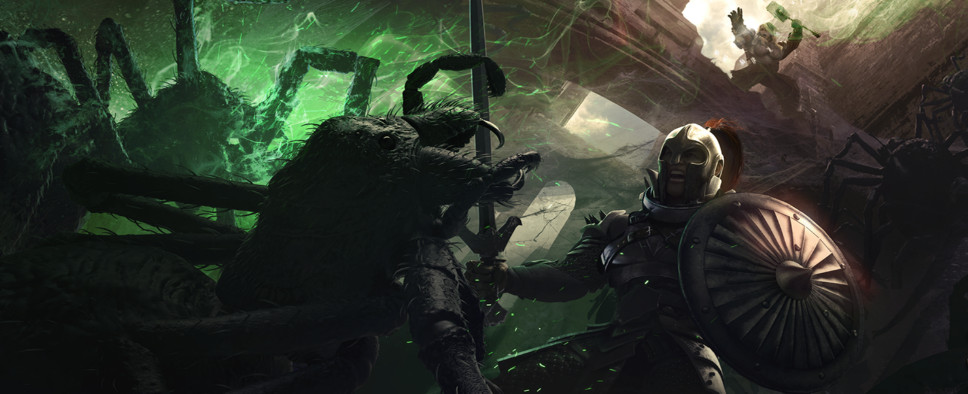Solasta: Crown of the Magister - Blades of the Old Worlds Community Vote
-
Category: News ArchiveHits: 1299

This month’s community vote for Tactical Adventures’ D&D-based RPG Solasta: Crown of the Magister eschews the part where people previously got to submit their item design ideas, and instead simply lets us vote for one of five exotic sword types. Here’s what you need to know:
When humans fled to Solasta it was not a matter of country or culture, it was a matter of survival. Centuries passed and much was lost, but more remains - if not among the living, then among the dead. Every ruin tells a story, but to the untrained eye of a looter, every blade is a sword. Most adventurers know better: a heritage, a legacy, many a thing can be found in a scavenger's bag.
Hello and welcome to May Community Vote everyone!
This time we have prepared a very special topic for our martial-loving friends: Exotic Weapons... And more specifically, Exotic Blades. Most of those who are familiar with Tabletop RPGs know that popular settings are often based on western culture - fairly logical considering most writers and players are American & European. I think it's safe to assume that it's much easier to introduce most players to a game where they can choose between a sword or a mace and run at the enemy, rather than have to explain the difference between a shamshir and a takoba (don't ask me, I'm not a specialist).
Now, 5e has streamlined quite a few rules to the benefit of game's flow, removing a lot of obscure and very specific rules. However, there are some of us who miss the large variety of weapons offered in 3.5... which led us to think "hey, why not add an exotic weapon to our game?". And here we are, with a selection of five blades from different cultures! Of course we'd love to implement all of them, but as usual we have to be careful not to overburden our development plans - so you'll have to choose which one makes it in! Note that I am by no mean an expert in ancient weaponry, so I apologize in advance if some of my descriptions aren't completely accurate (and if so, please feel free to mention it in the comments so that I can fix it!).
You have until May 25th, 11:59pm PST to vote!
Our first contender is the Khopesh (ḫpš). A one-handed Egyptian sickle-sword which apparently evolved from battle axes, the Khopesh is truly an ancient weapon - with the earliest known appearance dating from 2,500 BC. Sharpened on the outside portion of the curved end, the inside curve of the weapon could be used to trap an opponent's arm or pull their shield out of the way. Sadly, this fascinating weapon fell out of use around 1,300 BC.
Our second contender is the only non-human weapon in the list. The Elven Thinblade is a one-handed weapon that can be found in ruins of the old, now defunct elven empire - more often than not imbued with powerful magic. Very light and expertly crafted, many would kill to get their hands on such a weapon (and sometimes quite literally). On Tabletop, the Elven Thinblade first appeared in the Races of the Wild sourcebook (2005), and was quite ahead of the power curve when you consider that it was a weapon that dealt 1d8 dmg (like a longsword), had a 18-20 crit range (like a rapier), was versatile (could be wielded 2-handed for more damage) AND allowed weapon finesse (to swap strength for dexterity for damage). Now before you rogues and rangers start drooling, it will most likely not be as powerful in Solasta. Consider yourself warned!
Our third contender is the 2-handed Katana (刀) from Japan. Amongst all the foreign weapons, Katanas are probably the most well-known: a curved, slender, singled-edged blade with a long grip protected by a guard to accommodate two hands. With that said, the oldest Katanas from the 12th century may have been quite different from the popular image we have of it, as its design evolved multiple times over the centuries. They are rumoured to be among the finest cutting weapons in history, although many contest that statement.
Our fourth contender is another two-handed blade from Asia, the Chinese Da Dao (大刀)... which literally means "Big Blade" (大 = Big, 刀 = Single-edged blade, although nowadays it's mostly used for "Knife"). For those who are curious, it is indeed the 刀 from Katana - there are quite a large amount of words in Japanese and Chinese that are visually the same, although the pronunciation (and even the meaning) can differ. This large broadsword is characterized by the rings on the back of the blade (note that not all Da Dao have those), their purpose left to speculation. Some believe the noise helped intimidating opponents, others that it is a symbol of honour as the noise would prevent the wielder from attacking enemies in the back.
Last but not least is the 2-handed Falchion. There are many different type of falchions - cleaver falchions, cusped falchions... We decided to go with the blade illustrated in the 13th century Maciejowski Bible as we loved its design - although we swapped the handle for a more standard one (the original has a hooked hilt, which most likely would have caused clipping issues with character models). In 3.5e, Falchions were like the 2-handed version of scimitars - slashing, 18-20 crit range... however they only dealt a measly 2d4 damage, compared to the 2d6 (19-20 crit range) greatsword. Not to mention they were also more expensive (75 gp vs 50 gp) and weighted the same (8 lbs)! A cool weapons that definitely deserved a bit more spotlight.
So, which one tickled your fancy? Make sure to vote in our Official Forums!

